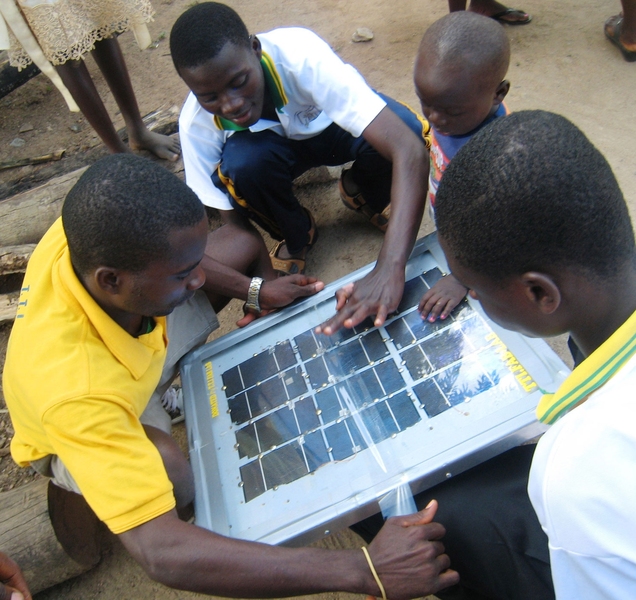What happens when you bring a high school class and a box of electronics to a mud-hut village on the western coast of Ghana? Two MIT students recently found out.
Thanks to funding from MIT’s Public Service Center, mechanical engineering sophomore Edward Burnell and physics senior Anna Waldman-Brown spent July and August developing a hands-on alternative energy curriculum at the Takoradi Technical Institute (TTI) Fabrication Lab in Ghana. The Fab Lab is an educational laboratory network that seeks to provide science and engineering education and encourage people to incorporate engineering design to improve the quality of their lives. Started at the Media Lab’s Center for Bits and Atoms, the Fab Lab encourages international collaborations with MIT students at its satellite locations around the world, all of which are equipped with high-end machining technology and circuitry components.
During a D-Lab trip last January to the town of Takoradi, a six-hour drive from Accra, Burnell’s group went to the TTI Fab Lab to teach classes on energy generation. Azasoo Emmanuel, the TTI Fab Lab manager, was thrilled to have MIT student teachers who shared his enthusiasm for hands-on science education. He invited Burnell back to help integrate practical science into the high school curriculum.
Several months later, surrounded by iguanas and coconut palms, Burnell, Waldman-Brown and Emmanuel went to work, devising a curriculum for the design and implementation of small-scale renewable energy technology to help solve rural Ghana’s urgent energy needs. They hoped to give the students practical experience and integrate the Fab Lab with the school and the broader community. But first, they had to dispel the prevailing belief that science takes place on the blackboard. This was achieved via daily classes and hands-on experimental labs.
The high school students put their knowledge into practice during field trips to the rural village of Kobina Adorh Krom, where they shared their inventions and ideas about alternative energy generation with local residents, and ultimately installed a solar energy system for the village.
To read more about this project, pick up a copy of the education-themed issue of Komaza available at campus newsstands or online at http://web.mit.edu/komaza
Thanks to funding from MIT’s Public Service Center, mechanical engineering sophomore Edward Burnell and physics senior Anna Waldman-Brown spent July and August developing a hands-on alternative energy curriculum at the Takoradi Technical Institute (TTI) Fabrication Lab in Ghana. The Fab Lab is an educational laboratory network that seeks to provide science and engineering education and encourage people to incorporate engineering design to improve the quality of their lives. Started at the Media Lab’s Center for Bits and Atoms, the Fab Lab encourages international collaborations with MIT students at its satellite locations around the world, all of which are equipped with high-end machining technology and circuitry components.
During a D-Lab trip last January to the town of Takoradi, a six-hour drive from Accra, Burnell’s group went to the TTI Fab Lab to teach classes on energy generation. Azasoo Emmanuel, the TTI Fab Lab manager, was thrilled to have MIT student teachers who shared his enthusiasm for hands-on science education. He invited Burnell back to help integrate practical science into the high school curriculum.
Several months later, surrounded by iguanas and coconut palms, Burnell, Waldman-Brown and Emmanuel went to work, devising a curriculum for the design and implementation of small-scale renewable energy technology to help solve rural Ghana’s urgent energy needs. They hoped to give the students practical experience and integrate the Fab Lab with the school and the broader community. But first, they had to dispel the prevailing belief that science takes place on the blackboard. This was achieved via daily classes and hands-on experimental labs.
The high school students put their knowledge into practice during field trips to the rural village of Kobina Adorh Krom, where they shared their inventions and ideas about alternative energy generation with local residents, and ultimately installed a solar energy system for the village.
To read more about this project, pick up a copy of the education-themed issue of Komaza available at campus newsstands or online at http://web.mit.edu/komaza






